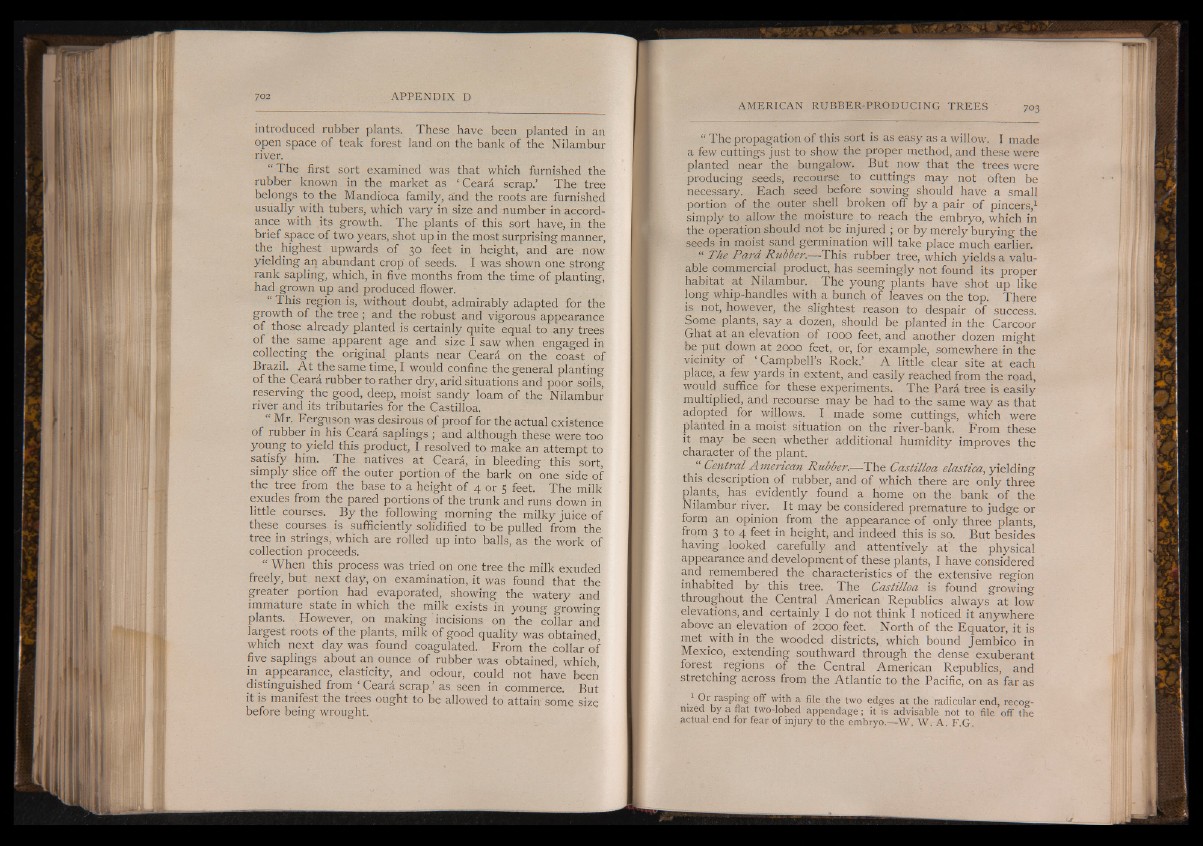
introduced rubber plants. These have been planted in an
open space of teak forest land on the bank of the Nilambur
river.
“ The first sort examined was that which furnished the
rubber known in the market as ‘ Ceard scrap.’ The tree
belongs to the Mandioca family, and the roots are furnished
usually with tubers, which vary in size and number in accordance
with its growth. The plants of this sort have, in the
brief space of two years, shot up in the most surprising manner,
the highest upwards of 30 feet in height, and are now
yielding an abundant crop of seeds. I was shown one strong
rank sapling, which, in five months from the time of planting,
had grown up and produced flower.
“ This region is, without doubt, admirably adapted for the
growth of the tree; and the robust and vigorous appearance
of those already planted is certainly quite equal to any trees
of the same apparent age and size I saw when engaged in
collecting the original plants near Ceard on the coast of
Brazil. A t the same time, I would confine the general planting
of the Ceara rubber to rather dry, arid situations and poor soils,
reserving the good, deep, moist sandy loam of the Nilambur
river and its tributaries for the Castilloa.
“ Mr. Ferguson was desirous of proof for the actual existence
of rubber in his Ceara saplings ; and although these were too
young to yield this product, I resolved to make an attempt to
satisfy him. The natives at Ceara, in bleeding this sort,
simply slice off the outer portion of the bark on one side of
the tree from the base to a height of 4 or 5 feet. The milk
exudes from the pared portions of the trunk and runs down in
little courses. By the following morning the milky juice of
these courses is sufficiently solidified to be pulled from the
tree in strings, which are rolled up into balls, as the work of
collection proceeds.
“ When this process was tried on one tree the milk exuded
freely, but next day, on examination, it was found that the
greater portion had evaporated, showing the watery and
immature state in which the milk exists in young growing
plants. However, on making incisions on the collar and
largest roots of the plants, milk of good quality was obtained,
which next day was found coagulated. From the collar of
five saplings about an ounce of rubber was obtained, which,
in appearance, elasticity, and odour, could not have been
distinguished from ‘ Ceani scrap.’ as seen in commerce. But
it is manifest the trees ought to be allowed to attain' some size
before being wrought.
“ The propagation of this sort is as easy as a willow. I made
a few cuttings just to show the proper method, and these were
planted near the bungalow. But now that the trees were
producing seeds, recourse to cuttings may not often be
necessary. Each seed before sowing should have a small
portion of the outer shell broken off by a pair of pincers,1
simply to allow the moisture to reach the embryo, which in
the operation should not be injured ; or by merely burying the
seeds in moist sand germination will take place much earlier.
“ The Para Rubber.— 'This rubber tree, which yields a valuable
commercial product, has seemingly not found its proper
habitat at Nilambur. The young plants have shot up like
long whip-handles with a bunch of leaves on the top. There
is not, however, the slightest reason to despair of success.
Some plants, say a dozen, should be planted in the Carcoor
Ghat at an elevation of 1000 feet, and another dozen might
be put down at 2000 feet, or, for example, somewhere in the
vicinity of 5 Campbell’s Rock.’ A little clear site at each
place, a few yards in extent, and easily reached from the road,
would suffice for these experiments. The Pard tree is easily
multiplied, and recourse may be had to the same way as that
adopted for willows. I made some cuttings, which were
planted in a moist situation on the river-bank. From these
it may be seen whether additional humidity improves the
character of the plant.
Central American Rubber.— The Castilloa elastica, yielding
this description of rubber, and of which there are only three
plants, has evidently found a home on the bank of the
Nilambur river. It may be considered premature to judge or
form an opinion from the appearance of only three plants,
from 3 to 4 feet in height, and indeed this is so. But besides
having looked carefully and attentively at the physical
appearance and development of these plants, I have considered
and remembered the characteristics of the extensive region
inhabited by this tree. The Castilloa is found growing
throughout the Central American Republics always at low
elevations, and certainly I do not think I noticed it anywhere
above an elevation of 2000 feet. North of the Equator, it is
met with in the wooded districts, which bound Jembico in
Mexico, extending southward through the dense exuberant
forest regions of the Central American Republics, and
stretching across from the Atlantic to the Pacific, on as far as
. 1 Or rasping off with a file the two edges at the radicular end, recognized
by a flat two-lobed appendage; it is advisable not to file off the
actual end for fear of injury to the embryo.— W. W, A. F.G,